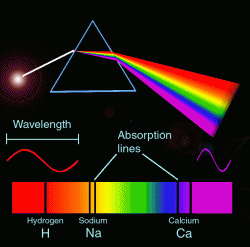 During the 20th and the 21st centuries, humanity greatly advanced in scientific development. The human mind has found ways to draw energy from the wind, sun, and earth; in about 30 years, Mars and the Moon will probably become inhabited; laser surgery, cybernetic prosthetics, and all kinds of mobile Internet technologies are becoming commonplace at the moment. One of such commonplaces—wonderful in their nature, but already routine and widely used—is the spectroscopy of stars, allowing astronomers to study stars located millions of light years away from Earth.
During the 20th and the 21st centuries, humanity greatly advanced in scientific development. The human mind has found ways to draw energy from the wind, sun, and earth; in about 30 years, Mars and the Moon will probably become inhabited; laser surgery, cybernetic prosthetics, and all kinds of mobile Internet technologies are becoming commonplace at the moment. One of such commonplaces—wonderful in their nature, but already routine and widely used—is the spectroscopy of stars, allowing astronomers to study stars located millions of light years away from Earth.

✅ AI Essay Writer ✅ AI Detector ✅ Plagchecker ✅ Paraphraser
✅ Summarizer ✅ Citation Generator
Spectroscopy is the analysis of light emitted by an astronomical object—be it a star, a galaxy, a nebula, and so on. Most of the information astronomers nowadays receive is acquired through spectroscopy. This method of analysis and observation had been invented long ago; the first steps to create it were taken in 1850 by Joseph Fraunhofer, who constructed the first crude spectroscope; since that time, this tool has been modernized and enhanced numerous times. Nowadays, in order to disperse light, scientists use diffraction gratings; this dispersed light is then projected onto a special device, a bit similar to a DSLR camera’s matrix. In the outcome, scientists get a 2-dimensional spectra in a digital format, and can extract all kinds of data from it (Cosmos).
Spectroscopy is done at all wavelengths of the electromagnetic spectrum, from radio waves to gamma rays; the focus is on optical or visible light having wavelengths between 360 and 760 nanometers (nm)—from deep blue to far red (University of Washington). However, it is the studying of cosmos that seems to be giving the most revolutionary results, in regard to physics and science in general.
Professor Fred Watson from the Australian Astronomical Observatory explains it in a simple way: “You take the light from a star, planet or galaxy and pass it through a spectroscope, which is a bit like a prism letting you split the light into its component colours […] It lets you see the chemicals being absorbed or emitted by the light source. From this you can work out all sorts of things” (ABC Science).
For instance, spectroscopy allows us to figure out the chemical composition of stars. It is possible due to emission lines and absorption lines. Emission lines are the radiation emitted by certain chemicals at very specific wavelengths when heated or electrically charged; absorption lines appear when the light from a hot source comes through a cooler gas, which cancels some of the emission lines (ABC Science). Every chemical creates its own emission and absorption lines, so they are a cosmic cipher for encrypting the periodical table, so to say.
Spectroscopy allows scientists to determine the direction and trajectory of an astronomical object’s movement, as well as its velocity; all this is possible due to the Doppler effect. Originally discovered while studying sound, the effect implies that when the source of sound gets closer to the observer, the frequency of sound becomes higher (because sound waves “compress” and become shorter), and when this source gets farther, the sound gets lower, because sound waves “stretch” in space. Surprisingly, the same works for light waves. The change in frequency of wavelengths allows astronomers to determine whether an object is moving towards or away from them. “In light waves, it causes things moving towards you to shift to shorter wavelengths at the blue end of the spectrum. And objects moving away from you shift to longer frequencies, at the red end of the spectrum” (ABC Science). Age, mass, and other parameters that astronomical objects possess can be also calculated solely due to spectroscopy.
If you have ever wondered how scientists manage to make all kinds of amazing discoveries about distant galaxies, or how they know what stars consist of, spectroscopy is the answer to your question. Discovered in the middle of the 19th century, it has become one of the major tools of studying the Universe. It allows astronomers to learn a lot about any observed object, starting from its mass and distance from Earth, and ending up with chemical composition, age, and temperature. In the future, humanity will probably invent even more sophisticated means of researching stars, but so far, spectroscopy is one of the most amazing and precise tools astrophysicists have.
References
“How Do Astronomers Use Light to Study Stars and Planets?” Ask an Expert (ABC Science). N.p., n.d. Web. 21 Oct. 2015.
“Spectroscopy.” COSMOS. N.p., n.d. Web. 21 Oct. 2015.
“Stellar Spectroscopy.” University of Washington. N.p., n.d. Web. 21 Oct. 2015.
Follow us on Reddit for more insights and updates.





Comments (0)
Welcome to A*Help comments!
We’re all about debate and discussion at A*Help.
We value the diverse opinions of users, so you may find points of view that you don’t agree with. And that’s cool. However, there are certain things we’re not OK with: attempts to manipulate our data in any way, for example, or the posting of discriminative, offensive, hateful, or disparaging material.